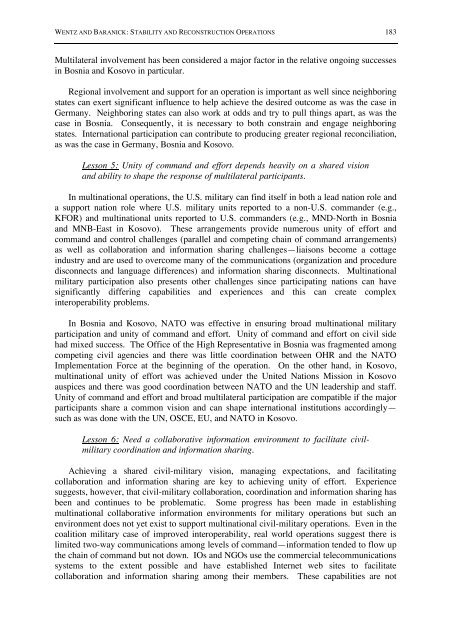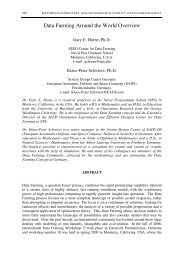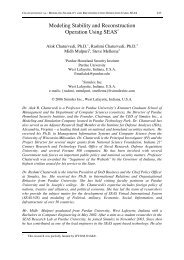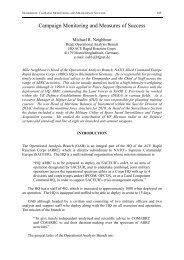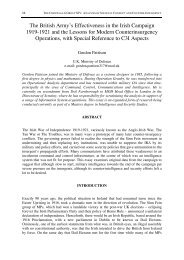Stability and Reconstruction Operations: What ... - Cornwallis Group
Stability and Reconstruction Operations: What ... - Cornwallis Group
Stability and Reconstruction Operations: What ... - Cornwallis Group
Create successful ePaper yourself
Turn your PDF publications into a flip-book with our unique Google optimized e-Paper software.
WENTZ AND BARANICK: STABILITY AND RECONSTRUCTION OPERATIONS 183<br />
Multilateral involvement has been considered a major factor in the relative ongoing successes<br />
in Bosnia <strong>and</strong> Kosovo in particular.<br />
Regional involvement <strong>and</strong> support for an operation is important as well since neighboring<br />
states can exert significant influence to help achieve the desired outcome as was the case in<br />
Germany. Neighboring states can also work at odds <strong>and</strong> try to pull things apart, as was the<br />
case in Bosnia. Consequently, it is necessary to both constrain <strong>and</strong> engage neighboring<br />
states. International participation can contribute to producing greater regional reconciliation,<br />
as was the case in Germany, Bosnia <strong>and</strong> Kosovo.<br />
Lesson 5: Unity of comm<strong>and</strong> <strong>and</strong> effort depends heavily on a shared vision<br />
<strong>and</strong> ability to shape the response of multilateral participants.<br />
In multinational operations, the U.S. military can find itself in both a lead nation role <strong>and</strong><br />
a support nation role where U.S. military units reported to a non-U.S. comm<strong>and</strong>er (e.g.,<br />
KFOR) <strong>and</strong> multinational units reported to U.S. comm<strong>and</strong>ers (e.g., MND-North in Bosnia<br />
<strong>and</strong> MNB-East in Kosovo). These arrangements provide numerous unity of effort <strong>and</strong><br />
comm<strong>and</strong> <strong>and</strong> control challenges (parallel <strong>and</strong> competing chain of comm<strong>and</strong> arrangements)<br />
as well as collaboration <strong>and</strong> information sharing challenges—liaisons become a cottage<br />
industry <strong>and</strong> are used to overcome many of the communications (organization <strong>and</strong> procedure<br />
disconnects <strong>and</strong> language differences) <strong>and</strong> information sharing disconnects. Multinational<br />
military participation also presents other challenges since participating nations can have<br />
significantly differing capabilities <strong>and</strong> experiences <strong>and</strong> this can create complex<br />
interoperability problems.<br />
In Bosnia <strong>and</strong> Kosovo, NATO was effective in ensuring broad multinational military<br />
participation <strong>and</strong> unity of comm<strong>and</strong> <strong>and</strong> effort. Unity of comm<strong>and</strong> <strong>and</strong> effort on civil side<br />
had mixed success. The Office of the High Representative in Bosnia was fragmented among<br />
competing civil agencies <strong>and</strong> there was little coordination between OHR <strong>and</strong> the NATO<br />
Implementation Force at the beginning of the operation. On the other h<strong>and</strong>, in Kosovo,<br />
multinational unity of effort was achieved under the United Nations Mission in Kosovo<br />
auspices <strong>and</strong> there was good coordination between NATO <strong>and</strong> the UN leadership <strong>and</strong> staff.<br />
Unity of comm<strong>and</strong> <strong>and</strong> effort <strong>and</strong> broad multilateral participation are compatible if the major<br />
participants share a common vision <strong>and</strong> can shape international institutions accordingly—<br />
such as was done with the UN, OSCE, EU, <strong>and</strong> NATO in Kosovo.<br />
Lesson 6: Need a collaborative information environment to facilitate civilmilitary<br />
coordination <strong>and</strong> information sharing.<br />
Achieving a shared civil-military vision, managing expectations, <strong>and</strong> facilitating<br />
collaboration <strong>and</strong> information sharing are key to achieving unity of effort. Experience<br />
suggests, however, that civil-military collaboration, coordination <strong>and</strong> information sharing has<br />
been <strong>and</strong> continues to be problematic. Some progress has been made in establishing<br />
multinational collaborative information environments for military operations but such an<br />
environment does not yet exist to support multinational civil-military operations. Even in the<br />
coalition military case of improved interoperability, real world operations suggest there is<br />
limited two-way communications among levels of comm<strong>and</strong>—information tended to flow up<br />
the chain of comm<strong>and</strong> but not down. IOs <strong>and</strong> NGOs use the commercial telecommunications<br />
systems to the extent possible <strong>and</strong> have established Internet web sites to facilitate<br />
collaboration <strong>and</strong> information sharing among their members. These capabilities are not


